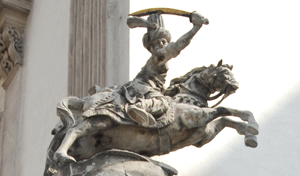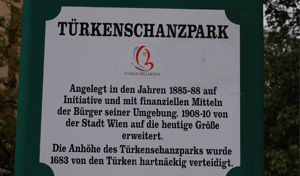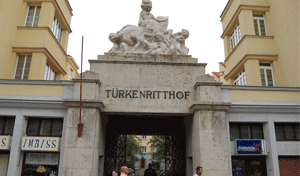Turkish Traces in Vienna
- Written by
- Published in Travel
*Prince Eugene, who served in the king’s army during the Second Siege of Vienna, defeated the Turks and gained a great victory at Zenta in 1697. Prince Eugene took back Belgrade from the Ottomans in 1717 and his body was interred in St.Stephen’s Cathedral. His statue in Heroes Square, which was unveiled in 1865, stands in front of the Austrian National Library.
The statue shows Prince Eugene on his horse which is trampling on Turkish bricks. The original or artificial Turkish cannon balls that symbolize the defense of Vienna and the retreat of the Turks, leaving everything behind, can be seen as decorations of victory on exterior walls of houses. One of these is the gold Turkish cannon ball at Am Hof 11 where the statue of Çerkez Dayı (Circassian Uncle) is in No.1 Vienna.

* At the corner of house number 3 on Gavur (Infidel) Street there is the statue of a small Turkish soldier on his rearing horse, holding a sword in his hand. This hero, whose story has spread from mouth to mouth, is known as Çerkez Dayı (Circassian Uncle) by the Turks and Gavur Ateşi (Infidel’s Fire) by the Austrians.
During the First Siege of Vienna by Sultan Suleiman the Magnificient a cannon ball breached a city wall. Çerkez Dayı entered the city through the opening without looking back and after a while realized that he was alone. He fought against the Austrian army until he was martyred.
King Ferdinand had this great hero and his horse embalmed and set up under the vault of a house. Thus, the square where Çerkez Dayı was martyred became known as the Çerkez Dayı Square. Over the course of centuries the information about the interred body and its fate was lost.The square, which was previously known as the “Çerkez Dayı Square”, is now called “Heidenschuss”

* One of the pictures of the Virgin Mary, who was called on to help during the Turkish wars, is “Maria Pötsch” which is immediately to the right of the entrance to St.Stephen’s Cathedral. This picture was designated as the palm for the battle of Zenta by Abraham a Sancta Clara, because shortly after the picture was fixed onto the main altar in the cathedral the news of Prince Eugene’s victory against the Turks in battle of Zenta was received.
The picture, which is known by the name Türkenmodanna, was called on for help and blessed in all Turkish wars. Again, a janissary trampled by a preacher and a statue with Turkish tile design are seen on the exterior north wall of the cathedral.
* The plate fixed to the corner of Kärtner Street in memory of the First Siege of Vienna describes the last attack of the Turks who were driven back on October 14, 1529. (July 4, 2008, Selahattin Sevi, Zaman)

*One of the public parks in Vienna which is visited by approximately 800 people daily is called the Turkish Park. Its German name is "Türkenschanzpark" The park was built between 1885 and 1888 in memory of the Second Siege of Vienna by financial contributions and the initiative of people living in the area; its landscape took its present form in 1910. Its German name, which means “Turkish Barracks”, is derived from the fact that the Ottoman Barracks were located in this region.










